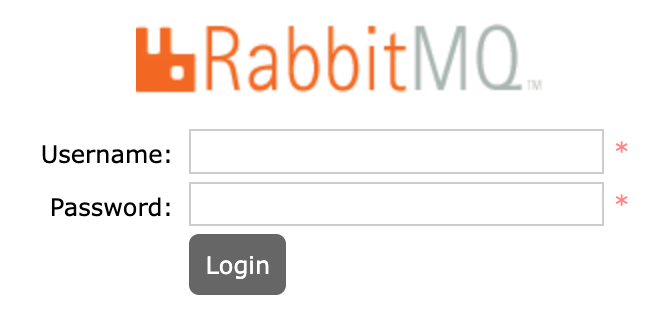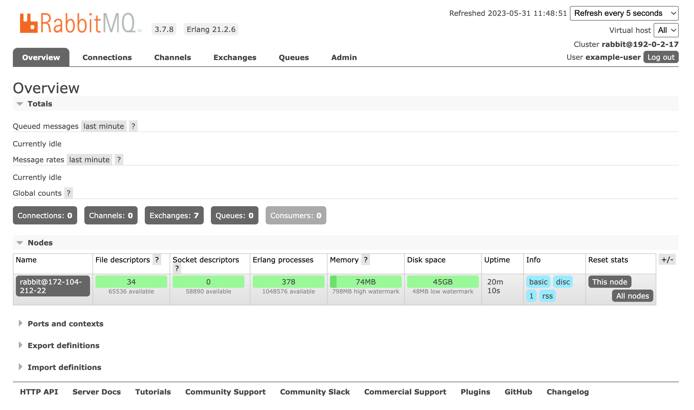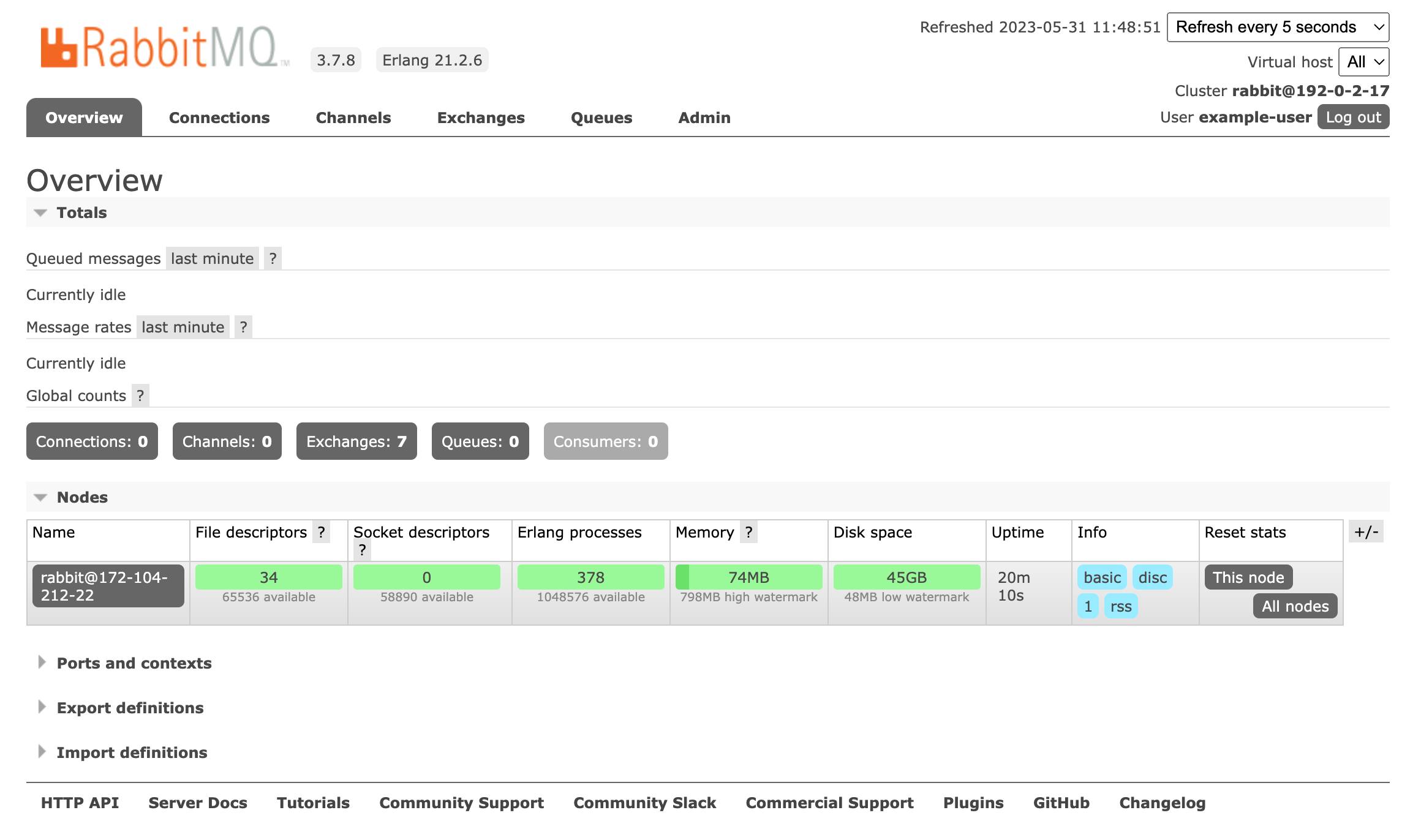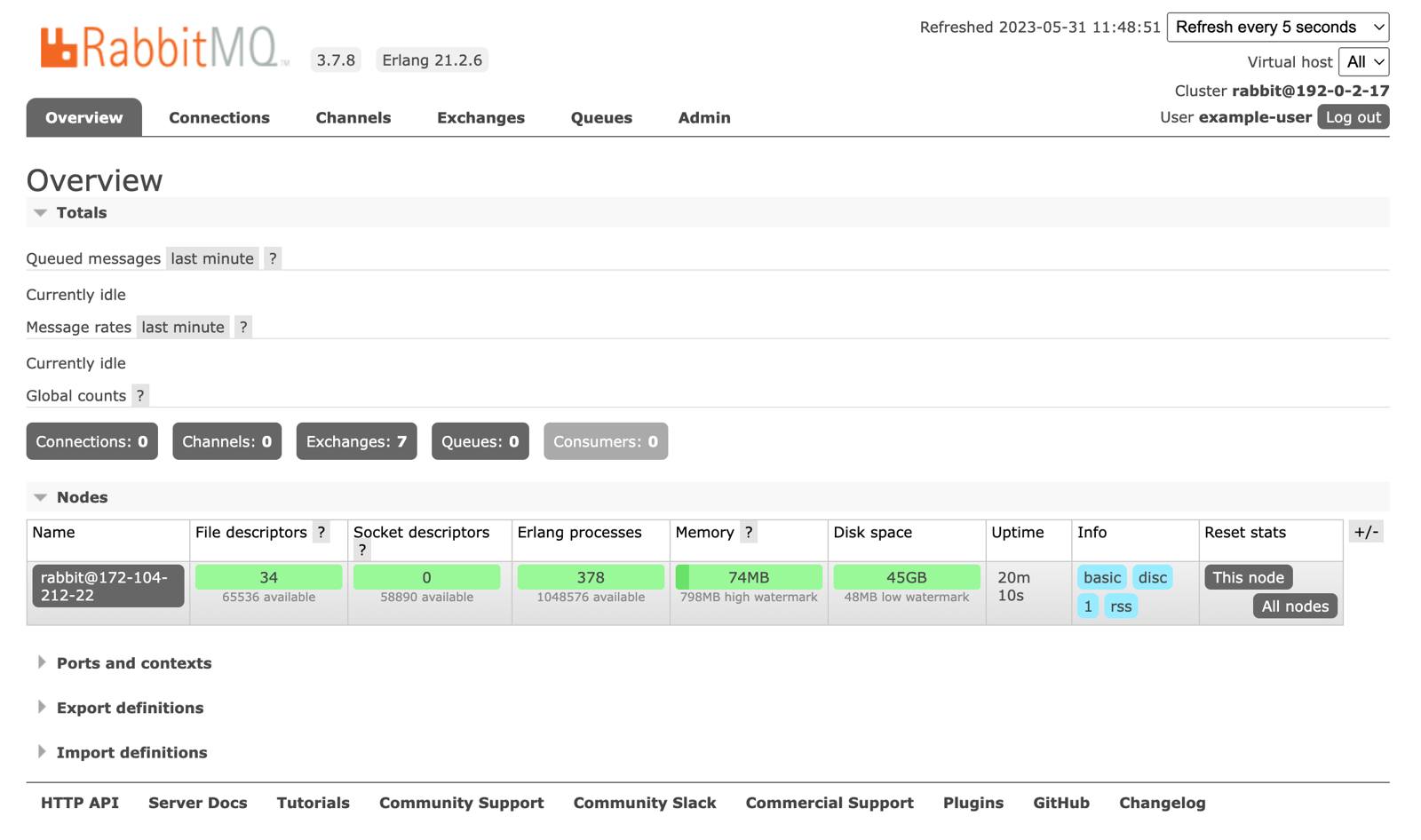Product docs and API reference are now on Akamai TechDocs.
Search product docs.
Search for “” in product docs.
Search API reference.
Search for “” in API reference.
Search Results
results matching
results
No Results
Filters
Deploy RabbitMQ through the Linode Marketplace
Quickly deploy a Compute Instance with many various software applications pre-installed and ready to use.
RabbitMQ is a popular open source message broker, or a tool that enables and empowers components of a system to communicate from a centralized source or application. By “translating” data from a number of different sources into a unified language, RabbitMQ allows component services to interact with each other through a centralized method.
The RabbitMQ Marketplace App installs a RabbitMQ server and a basic default configuration to assist with messaging tasks. By accessing The RabbitMQ Management console, you can further configure RabbitMQ and view important analytics at any time.
Deploying a Marketplace App
The Linode Marketplace lets you easily deploy software on a Compute Instance using Cloud Manager. See Get Started with Marketplace Apps for complete steps.
Log in to Cloud Manager and select the Marketplace link from the left navigation menu. This displays the Linode Create page with the Marketplace tab pre-selected.
Under the Select App section, select the app you would like to deploy.
Complete the form by following the steps and advice within the Creating a Compute Instance guide. Depending on the Marketplace App you selected, there may be additional configuration options available. See the Configuration Options section below for compatible distributions, recommended plans, and any additional configuration options available for this Marketplace App.
Click the Create Linode button. Once the Compute Instance has been provisioned and has fully powered on, wait for the software installation to complete. If the instance is powered off or restarted before this time, the software installation will likely fail.
To verify that the app has been fully installed, see Get Started with Marketplace Apps > Verify Installation. Once installed, follow the instructions within the Getting Started After Deployment section to access the application and start using it.
Configuration Options
- Supported distributions: Ubuntu 24.04 LTS
- Recommended minimum plan: All plan types and sizes can be used.
RabbitMQ Options
- Email address (required): Email address to use for generating the SSL certificates and configuring the server and DNS records.
- Allowed IPs (required): IP addresses allowed to access the Management UI.
- The version of RabbitMQ you’d like installed (required): RabbitMQ version to be installed during the setup.
- RabbitMQ Admin Username (required): RabbitMQ admin username.
- RabbitMQ Username (required): RabbitMQ limited AMQP user. Make sure to use a username different from the RabbitMQ Admin Username.
Limited Sudo User
You need to fill out the following fields to automatically create a limited sudo user, with a strong generated password for your new Compute Instance. This account will be assigned to the sudo group, which provides elevated permissions when running commands with the sudo prefix.
Limited sudo user: Enter your preferred username for the limited user. No Capital Letters, Spaces, or Special Characters.
Locating The Generated Sudo Password A password is generated for the limited user and stored in a
.credentialsfile in their home directory, along with application specific passwords. This can be viewed by running:cat /home/$USERNAME/.credentialsFor best results, add an account SSH key for the Cloud Manager user that is deploying the instance, and select that user as an
authorized_userin the API or by selecting that option in Cloud Manager. Their SSH pubkey will be assigned to both root and the limited user.Disable root access over SSH: To block the root user from logging in over SSH, select Yes. You can still switch to the root user once logged in, and you can also log in as root through Lish.
Accessing The Instance Without SSH If you disable root access for your deployment and do not provide a valid Account SSH Key assigned to theauthorized_user, you will need to login as the root user via the Lish console and runcat /home/$USERNAME/.credentialsto view the generated password for the limited user.
Custom Domain (Optional)
If you wish to automatically configure a custom domain, you first need to configure your domain to use Linode’s name servers. This is typically accomplished directly through your registrar. See Use Linode’s Name Servers with Your Domain. Once that is finished, you can fill out the following fields for the Marketplace App:
- Linode API Token: If you wish to use the Linode’s DNS Manager to manage DNS records for your custom domain, create a Linode API Personal Access Token on your account with Read/Write access to Domains. If this is provided along with the subdomain and domain fields (outlined below), the installation attempts to create DNS records via the Linode API. See Get an API Access Token. If you do not provide this field, you need to manually configure your DNS records through your DNS provider and point them to the IP address of the new instance.
- Subdomain: The subdomain you wish to use, such as www for
www.example.com. - Domain: The domain name you wish to use, such as example.com.
") within any of the App-specific configuration fields, including user and database password fields. This special character may cause issues during deployment.Obtain the Credentials
Once the app is deployed, you need to obtain the credentials from the server.
To obtain credentials:
Log in to your new Compute Instance using one of the methods below:
- Lish Console: Log in to Cloud Manager, click the Linodes link in the left menu, and select the Compute Instance you just deployed. Click Launch LISH Console. Log in as the
rootuser. To learn more, see Using the Lish Console. - SSH: Log in to your Compute Instance over SSH using the
rootuser. To learn how, see Connecting to a Remote Server Over SSH.
- Lish Console: Log in to Cloud Manager, click the Linodes link in the left menu, and select the Compute Instance you just deployed. Click Launch LISH Console. Log in as the
Run the following command to access the credentials file:
cat /home/$USERNAME/.credentials
This returns passwords that were automatically generated when the instance was deployed. Save them. Once saved, you can safely delete the file.
Getting Started After Deployment
To get started:
Open a web browser and navigate to the domain you entered when creating the instance:
https://domain.tld. If you didn’t enter a domain, use your Compute Instance’s default rDNS domain (192-0-2-1.ip.linodeusercontent.com). To learn more on viewing the rDNS value, see Managing IP Addresses. Make sure to use thehttpsprefix in the URL to access the website securely.Log in with your username and password found in your /home/$USERNAME/.credentials file.

Now, you have full access to the RabbitMQ Management Console and you can start configuring your application.



To learn more on RabbitMQ, see RabbitMQ Tutorials.
More Information
You may wish to consult the following resources for additional information on this topic. While these are provided in the hope that they will be useful, please note that we cannot vouch for the accuracy or timeliness of externally hosted materials.
This page was originally published on
